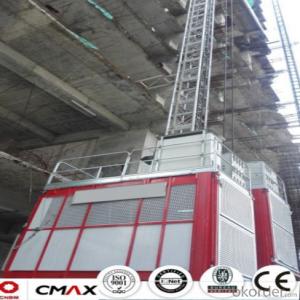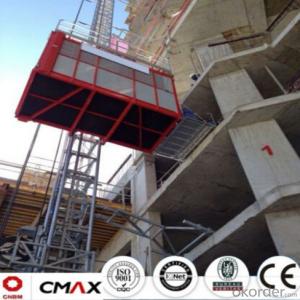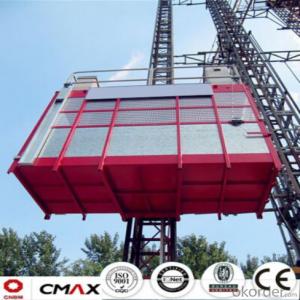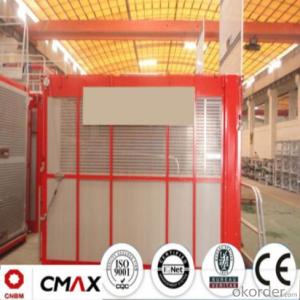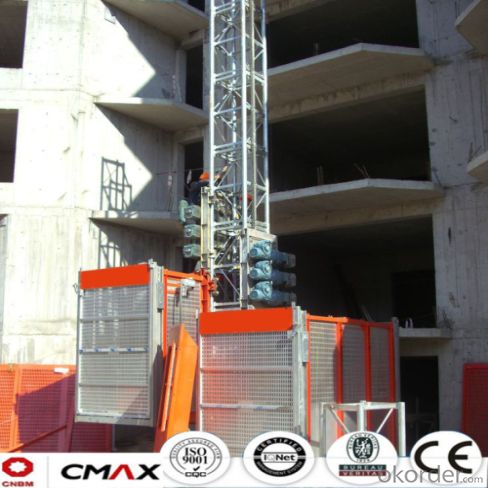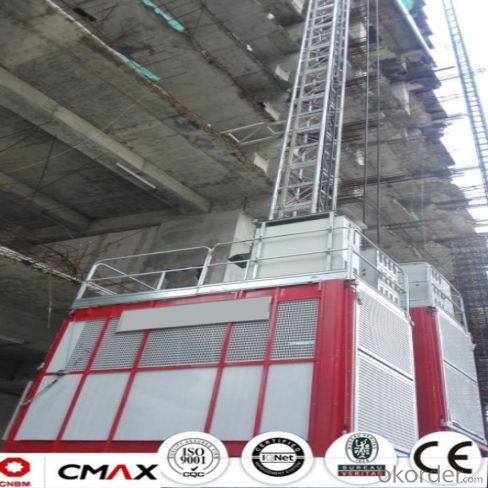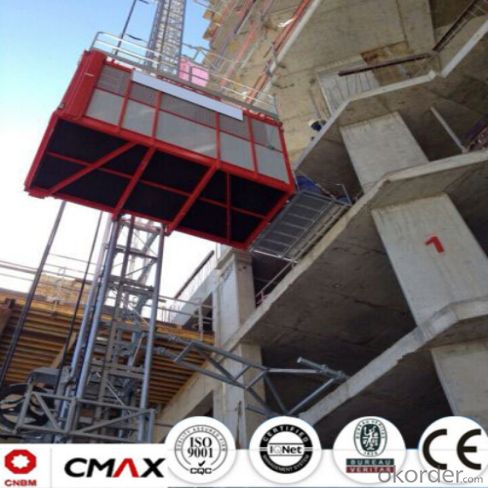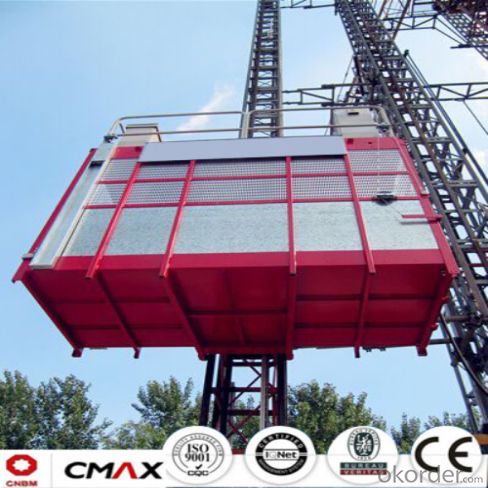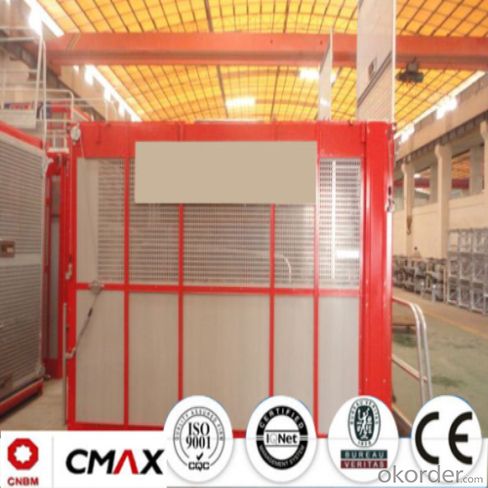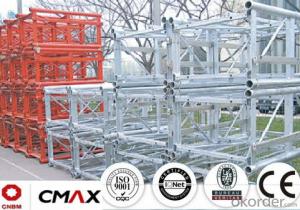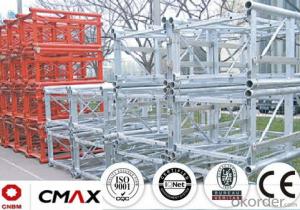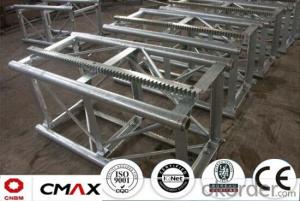Building Hoist Mast Section Spare Parts Manufacturer
- Loading Port:
- China main port
- Payment Terms:
- TT OR LC
- Min Order Qty:
- 1 unit
- Supply Capability:
- 5 unit/month
OKorder Service Pledge
OKorder Financial Service
You Might Also Like
Structure of Building Hoist Description
1.The gearing select perfect bearing,strong cables and oil seal.
2.The electrical parts select products from famous world manufacturers for example Schneider,Siemens and LG.
3.The racks and pinion select advanced material and advanced technique,which enhance the life of all parts.
4.The steel structure adopted strong steel from famous native manufacturers.
5.The surface of the steel structure can adopt paint-spray,parkerizing baking finish or hot galvanizing processing depending on users requirement.
6.The cage can be made and decorated by aluminum molded board,punched-plate or figured aluminum board.
Packaging & Delivery of Building Hoist
Packaging: nude and wooded box Delivery: 25-30days
Mains Parts of Building Hoist
1.The steel structure for example the mast, tie in and cabin ,could be all spay-painted and hot galvanized. Mast section is made with high quality Q345B which is the top standared in China.
2.Electrical parts are all adopted with Schneider , Siemens and other famous brands.
3.The electrical system can be selected with the normal control method and VVVF+PLC control way. Inverter we selected is from Schneider. Yaskawa or other world renowned brand.
4.Cabin exit door select ramping type. The ramping door looks like a bridge between the construction hoist and construction building.
5.The cabin floor is made from 3MM thickness steel riffled board(Hot dip galvanized), and 15MM thickness wooden board which can reduce the vibration and deformation a lot.
6.Driving unit is adopted the products from ZHANGJIANG and other reputed maker, or from SEW, NORD.
7.Safety system is mainly composed of electrical motor braking, anti-drop safety device, top & bottom limit switches, top & bottom 3-phase switches, door limit switches, buffer device and over-load protection. The system aims to ensure the hoist are running safely.
8.Qualification: CE, ISO9001:2008 and etc.
9.The long-term operation of CMAX building hoists testifies CMAX hoist is working performance is stable.
Building Hoist Images



Building Hoist Specification

FAQ of Building Hosit
Q: What is the building hoist main purpose?
A: Building hoist equipped with double or single cabin to transport the materials and labors up and down. It's the ideal construction equipment for vertical transportation in the field of construction.
Q: What is the main structure of building hoist?
A: The P/M construction hoist mainly contains metal structure, driving system, electrical control system, cable guide & protection system, electrical top crane and safety device.
Q: What is the meaning of the building hoist’s code?
A: Take SC200/200 for example: “SC” stands for rack and pinion hoist, “200/200” stands for double cage and capacity is 2 tons per cage. “SC200” stands for single cage and capacity is 2 tons.
Q: What is the dimension of the cage?
A: Normally the cage dimension is 3X1.5X2.5M (L/W/H) for 2t type hoist. Details should be checked according to our
quotation sheet. Also, the size can be customized according to the factual site condition. There are two doors (entrance& exit doors) for each cage, It can be produced as up & down sliding or ramping model for safety and convenience.
- Q: The user is inquiring about the possibility of purchasing a second-hand construction hoist.
- <p>Yes, you can buy a used building hoist. Many companies specialize in selling refurbished or used construction equipment, including building hoists. You can find them through online marketplaces, auction sites, or by contacting construction equipment dealers directly. It's important to inspect the hoist for any damages or wear and ensure it meets safety standards before purchase. Additionally, consider the hoist's age, maintenance history, and any warranties that might still be valid.</p>
- Q: Is it possible for one operator to manage several lifting devices, including a Building Hoist, at the same time?
- <p>Yes, it is possible for a single operator to handle the operation of multiple lifting devices, including Building Hoists, depending on the specific equipment and safety regulations. Modern building hoists are often designed with advanced controls that allow for efficient management of multiple units. However, this must be done in compliance with local laws and safety standards, which may require additional training or certifications for the operator. It's crucial to ensure that the operator has the necessary skills and that the operation does not compromise safety.</p>
- Q: How does the driver of the construction elevator do the search for a sudden power failure
- There are clear rules for the safety of construction machinery (JGJ33-2001). 6.12.17 when the elevator is running in an existing abnormal condition, it should stop immediately and take effective measures to reduce the cage down to the ground level, and keep running after the failure. When the electric is out of control in operation, the stop button should be pressed immediately. The stop button is not allowed until the failure is ruled out. 6.12.20 when elevator in the operation of the midway stop due to power outages or other reasons, can be manually, the end of a motor brake electromagnet manual release slowly shake handshandle pull outward, slowly slide down the ladder cage, ladder cage fall shall not exceed the rated speed, manually drop must be conducted by professional maintenance personnel manipulation.
- Q: Is it possible to use two lifting devices simultaneously to lift an object that is heavier than the maximum weight each device can handle individually?
- <p>Yes, two lifting devices can be used together to lift a heavier object than either one can handle alone, provided that both devices are capable of supporting the combined weight and are properly synchronized. This requires careful planning and coordination to ensure the safety of the operation and the integrity of the lifting devices. The total weight capacity of the combined system should be greater than the weight of the object being lifted, and the devices must be designed to work in tandem without overloading or causing damage.</p>
- Q: This question asks for a comparison of the pros and cons associated with the use of building hoists in construction projects.
- <p>Building hoists offer several advantages, including increased efficiency in material transportation, reduced labor costs, and improved safety by minimizing the need for manual handling at height. They can also be used for personnel transport, enhancing site accessibility. However, there are disadvantages such as high initial costs, the need for regular maintenance and inspection, and potential downtime due to mechanical issues. Additionally, they require space for installation and can obstruct views or access during operation. Safety concerns also arise if not properly managed, as accidents can occur due to operator error or mechanical failure.</p>
- Q: This question asks for the steps or methods to keep a building hoist in good condition and fix any damages.
- <p>To maintain and repair a damaged building hoist, follow these steps: Regularly inspect the hoist for wear and tear, checking cables, pulleys, and brackets. Lubricate moving parts to reduce friction and prevent rust. Replace damaged or worn-out components promptly. Ensure all safety features are functioning correctly. If a hoist is severely damaged, consult with a professional to assess the damage and perform necessary repairs. Always adhere to the manufacturer's guidelines and safety regulations during maintenance and repair processes.</p>
- Q: For example, what records do you want to have a third party monitoring?
- Important parts replacement needs to be changed to the qualification, the procedure is like the new ladder, according to the new ladder standard test.
- Q: This question asks if building hoists can be utilized in both commercial and residential structures.
- <p>Yes, building hoists can be used for both commercial and residential buildings. They are essential in construction projects to efficiently transport materials and personnel vertically within the building structure. In commercial buildings, they aid in the construction of offices, retail spaces, and other similar structures. In residential buildings, they are used for constructing apartments, condominiums, and single-family homes. The choice of hoist type and capacity depends on the specific requirements of the project, such as the height of the building, the weight of materials to be transported, and the number of workers needing to be moved.</p>
- Q: This question asks for a description of the process of using a hydraulic cylinder in the context of a building hoist.
- <p>To use a hydraulic cylinder in a building hoist, first ensure the hoist is properly installed and secured. Connect the hydraulic cylinder to the hoist's power source, typically a hydraulic pump. The pump pressurizes hydraulic fluid, which is then directed into the cylinder. As the fluid enters, it pushes a piston within the cylinder, causing it to extend and lift the load. To lower the load, the fluid is released from the cylinder, allowing the piston to retract. Always monitor the pressure and ensure the system is leak-free for safe operation. Regular maintenance, including checking seals and lubricating parts, is crucial to prolong the life of the hydraulic cylinder and ensure efficient hoist performance.</p>
- Q: The elevator is banned from using elevators for more than a class of high winds
- When the wind speed is more than 13 meters per second, the installation and disassembly is forbidden. When the wind speed exceeds 20m/s and the weather, such as hail, the elevator should not be used. This is the norm M/s is about 8, and 13m/s is about 6
Send your message to us
Building Hoist Mast Section Spare Parts Manufacturer
- Loading Port:
- China main port
- Payment Terms:
- TT OR LC
- Min Order Qty:
- 1 unit
- Supply Capability:
- 5 unit/month
OKorder Service Pledge
OKorder Financial Service
Similar products
Hot products
Hot Searches
Related keywords

